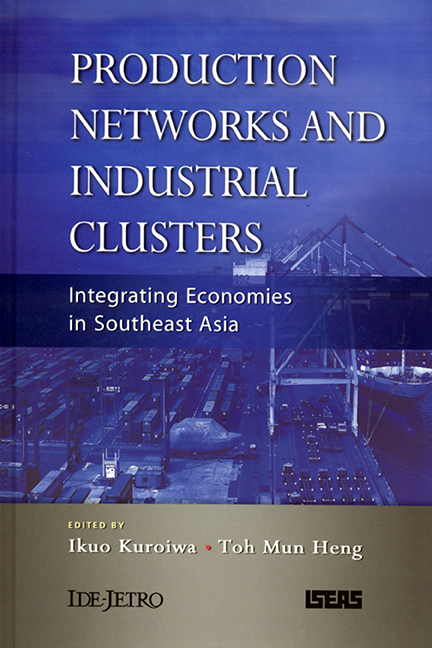Book contents
- Frontmatter
- Contents
- List of Tables
- List of Figures
- Preface
- Acknowledgements
- Contributors
- 1 Introduction
- I Overview of the Production Networks and Industrial Clusters in Southeast Asia
- II Case Studies
- 5 Industrial Clustering of Electronics Firms in Indonesia and Malaysia
- 6 The Biomedical Science (BMS) Industry in Singapore: Can It Plug into the Global Value Chain?
- 7 The Development of Automotive Industry Clusters and Production Networks in Thailand
- III Drivers for the Expanding Production Networks
- Index
6 - The Biomedical Science (BMS) Industry in Singapore: Can It Plug into the Global Value Chain?
from II - Case Studies
Published online by Cambridge University Press: 21 October 2015
- Frontmatter
- Contents
- List of Tables
- List of Figures
- Preface
- Acknowledgements
- Contributors
- 1 Introduction
- I Overview of the Production Networks and Industrial Clusters in Southeast Asia
- II Case Studies
- 5 Industrial Clustering of Electronics Firms in Indonesia and Malaysia
- 6 The Biomedical Science (BMS) Industry in Singapore: Can It Plug into the Global Value Chain?
- 7 The Development of Automotive Industry Clusters and Production Networks in Thailand
- III Drivers for the Expanding Production Networks
- Index
Summary
OVERVIEW OF THE SINGAPORE ECONOMY
Singapore is well-known to be a model economy that achieves remarkable economic growth over the last thirty years with heavy dependence on foreign direct investment. There is always a lingering question of whether such a model which yielded an average eight per cent annual GDP growth over the last four decades can be sustained. One school of thought is that the model based on FDI and export-led growth is relevant given the small size of the domestic economy. Nonetheless, it is also not surprising that there are others that call for a more sustainable development that focuses on indigenous enterprise development, promotion and expansion as a means to compliment and reduce the over reliance on TNCs for economic growth.
This paper reckons that FDI will continue to be a strategic component for the growth of the Singapore economy despite development of local enterprises and the advances in information and communication technology (ICT). However, the composition of the multinational activities in the city state is expected to change due to the emergence of large economies of China and India which are endowed with large labour resources and market potential. FDI outflows will continue to be a potent factor to integrate the world economies, but the types and qualities of FDI are far from uniform. The multitude of these outflows with different attributes have enabled ever new and growing opportunities to be exploited and tapped for powering economic growth (WIR 2004).
As Singapore transits into a higher value-added economy, the economic growth is expected to be moderated. This is depicted in quantitative terms in Table 6.1, where the average annual growth rate of GDP which average 9 per cent during 1965 to 1989, has slowed to an average of 7.7 per cent in the 1990s, and further down to 4.1 per cent during 2000–05.
The development of an economy may undergo four different phases of growth: (1) factor driven, (2) investment driven, (3) innovation driven, and (4) wealth driven (Porter 1990). In the initial phase, economic growth may be solely derived from effective factor allocation and mobilization of basic factors of production such as labour and natural resources in the establishment of more labour intensive industries. The changes in the relative factor prices will be the catalyst for the second phase of development.
- Type
- Chapter
- Information
- Production Networks and Industrial ClustersIntegrating Economies in Southeast Asia, pp. 158 - 195Publisher: ISEAS–Yusof Ishak InstitutePrint publication year: 2008

